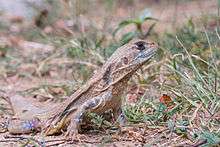Leiolepis
Leiolepis, commonly known as butterfly lizards or butterfly agamas (Thai: แย้), are group of agamid lizards.[1][2] They are native to Peninsular Malaysia, Thailand, Myanmar, Laos, Cambodia, Indonesia, Ryukyu Islands (Japan), Vietnam, and Hainan (China). The genus includes both sexual and asexual species.[2] Leiolepis is the sole genus of subfamily Leiolepidinae.
| Leiolepis | |
|---|---|
 | |
| Common butterfly lizard, L. belliana | |
| Scientific classification | |
| Kingdom: | Animalia |
| Phylum: | Chordata |
| Class: | Reptilia |
| Order: | Squamata |
| Suborder: | Iguania |
| Family: | Agamidae |
| Subfamily: | Leiolepidinae |
| Genus: | Leiolepis Cuvier, 1829 |
| Species | |
|
9 spp., see text | |
Description and ecology
Leiolepis are moderately sized lizards with the largest snout-to-vent length of 18 cm (7.1 in). Sexual species show sexual dimorphism. They are diurnal and live in flat, open areas with loose soil, which allows them to construct long, interconnected burrows used for refuge. They are omnivorous.[2]
Species
At least nine species are recognized as being valid.[1]
- Sexual species:
- L. belliana (Hardwicke & Gray, 1827) – common butterfly lizard
- L. guttata Cuvier, 1829 – giant butterfly lizard, spotted butterfly lizard
- L. peguensis G. Peters, 1971 – Burmese butterfly lizard
- L. reevesii (Gray, 1831) – Chinese butterfly lizard, Reeves' butterfly lizard
- L. rubritaeniata Mertens, 1961
- Asexual species:
- L. boehmei Darevsky & Kupriyanova, 1993 – Böhme's butterfly lizard
- L. guentherpetersi Darevsky & Kupriyanova, 1993 – Peters' butterfly lizard
- L. ngovantrii J. Grismer & L. Grismer, 2010 – Ngo Van Tri's lady butterfly lizard[2]
- L. triploida G. Peters, 1971 – Thai butterfly lizard, Malayan butterfly lizard
Nota bene: A binomial authority in parentheses indicates that the species was originally described in a genus other than Leiolepis.
Asexual species have arisen through hybridization of sexually-reproducing species.[2]
Relationship to humans
Captivity
Butterfly lizards are popular in the pet trade.
Consumption
In the northeast region of Thailand it is popular to catch butterfly lizards and eat them.[3] In the South Central Coast region of Vietnam, especially in Ninh Thuan Province, Leiolepis is considered a delicacy for its nutrional value and can fetch high prices on the market.[4]
Traditional game
In Prachuap Khiri Khan Province, Thailand, there is a traditional game called "yæ̂ lng rū" (แย้ลงรู; literally: "butterfly lizards hole down"[5]).
References
| Wikimedia Commons has media related to Leiolepis. |
| Wikispecies has information related to Leiolepis |
- Leiolepis at the Reptarium.cz Reptile Database. Accessed 26 September 2017.
- Grismer, Jesse L.; Grismer, L. Lee (2010). "Who's your mommy? Identifying maternal ancestors of asexual species of Leiolepis Cuvier, 1829 and the description of a new endemic species of asexual Leiolepis Cuvier, 1829 from Southern Vietnam" (PDF). Zootaxa. 2433: 47–61.
- "ชาวมหาสารคามแห่จับแย้-กะปอม ทำเมนูเด็ด 'ผัดกะเพราแย้' กินเองลดค่าใช้จ่าย". PPTV (in Thai). 28 April 2015. Retrieved 3 June 2016.
- "Ăn thịt kỳ đà có tác dụng gì ? cách nấu thịt kỳ đà". cotacdunggi.com (in Vietnamese). Retrieved 5 December 2016.
- "แย้ลงรู". Ministry of Culture (in Thai). Retrieved 5 June 2013.